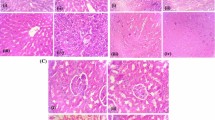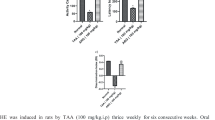Abstract
Acute hyperammonemia (HA) induced oxidative stress in the brain is considered to play critical roles in the neuropathology of end stage hepatic encephalopathy (HE). Moderate grade HA led minimal/moderate type HE is more common in the patients with chronic liver failure. However, implication of oxygen free radical (\( {\text{O}}_{ 2}^{ - } \)) based oxidative mechanisms remain to be defined during moderate grade HA. This article describes profiles of all the antioxidant enzymes Vis a Vis status of oxidative stress/damage in the brain slices exposed to 0.1–1 mM ammonia, reported to exist in the brain of animals with chronic liver failure and in liver cirrhotic patients. Superoxide dismutase catalyzes the first step of antioxidant mechanism and, with concerted activity of catalase, neutralizes \( {\text{O}}_{ 2}^{ - } \) produced in the cells. Both these enzymes remained unchanged up to 0.2–0.3 mM ammonia, however, with significant increments (P < 0.01–0.001) in the brain slices exposed to 0.5–1 mM ammonia. This was consistent with the similar pattern of production of reactive oxygen species in the brain slices. However, level of lipid peroxidation remained unchanged throughout the ammonia treatment. Synchronized activities of glutathione peroxidase and glutathione reductase regulate the level of glutathione to maintain reducing equivalents in the cells. The activities of both these enzymes also increased significantly in the brain slices exposed to 0.5–1 mM ammonia with concomitant increments in GSH/GSSG ratio and in the levels of total and protein bound thiol. The findings suggest resistance of brain cells from ammonia induced oxidative damage during moderate grade HA due to concordant activations of antioxidant enzymes.








Similar content being viewed by others
References
Felipo V, Butterworth RF (2002) Neurobiology of ammonia. Prog Neurobiol 67:259–279
Butterworth RF (2000) Hepatic encephalopathy: a neuropsychiatric disorder involving multiple neurotransmitter systems. Curr Opin Neurol 13:721–727
Rama Rao KV, Norenberg MD (2001) Cerebral energy metabolism in hepatic encephalopathy and hyperammonemia. Metab Brain Dis 16:67–78
Kosenko E, Felipo V, Montoliu C et al (1996) Effects of acute hyperammonemia in vivo on oxidative metabolism in nonsynaptic rat brain mitochondria. Metab Brain Dis 12:69–82
Rama Rao KV, Jayakumar AR, Norenberg MD (2005) Role of oxidative stress in the ammonia-induced mitochondrial permeability transition in cultured astrocytes. Neurochem Int 47:31–38
Albrecht J, Węgrzynowicz M (2007) Cyclic GMP in blood and minimal hepatic encephalopathy: fine tuning of the diagnosis. J Mol Med 85:203–205
Felipo V (2009) Hyperammonemia. In: Lajtha A, Banik N, Ray SK (eds) Handbook of neurochemistry and molecular neurobiology, brain and spinal cord trauma, 3rd edn. Springer, Berlin, pp 43–69
Emerit J, Edeas M, Bricaire F (2004) Neurodegenerative disease and oxidative stress. Biomed Pharmacother 58:39–46
Magistretti PJ (2003) Brain energy metabolism. In: Squire LR (ed) Fundamental neuroscience, 2nd edn. Elsevier, New York, pp 339–360
Singh S, Koiri RK, Trigun SK (2008) Acute and chronic hyperammonemia modulate antioxidant enzymes differently in cerebral cortex and cerebellum. Neurochem Res 33:103–113
Singh S, Trigun SK (2010) Activation of neuronal nitric oxide synthase in cerebellum of chronic hepatic encephalopathy rats is associated with up-regulation of nadph-producing pathway. Cerebellum 9:384–397
Murthy CR, Rama Rao KV, Bai G et al (2001) Ammonia-induced production of free radicals in primary cultures of rat astrocytes. J Neurosci Res 66:282–288
Rama Rao KV, Chen M, Simard JM et al (2003) Suppression of ammonia-induced astrocyte swelling by cyclosporin A. J Neurosci Res 74:891–897
Norenberg MD, Jayakumar AR, Rama Rao KV (2004) Oxidative stress in the pathogenesis of hepatic encephalopathy. Metab Brain Dis 19:313–329
Schliess F, Gorg B, Fischer R et al (2002) Ammonia induces MK-801-sensitive nitration and phosphorylation of protein tyrosine residues in rat astrocytes. FASEB J 16:739–741
Hermenegildo C, Monfort P, Felipo V (2000) Activation of N-methyl-d-aspartate receptors in rat brain in vivo following acute ammonia intoxication: characterization by in vivo brain microdialysis. Hepatology 31:709–715
Albrecht J (2007) Ammonia toxicity in the central nervous system. In: Lajtha A (ed) Handbook of neurochemistry and molecular neurobiology. Amino acids and peptides in the nervous system. Springer, Berlin, pp 261–276
Wang T, Kass S (1997) Preparation of brain slices. In: Rayne RC (ed) Neurotransmitter methods. Humana press, Totowa, pp 1–14
Pandey P, Singh SK, Trigun SK (2005) Developing brain of moderately hypothyroid mice shows adaptive changes in the key enzymes of glucose metabolism. Neurol Psychiat Brain Res 12:159–164
Lowry OH, Rosebrough NJ, Farr AL et al (1951) Protein measurement with the folin phenol reagent. J Biol Chem 193:265–275
Montoliu C, Valles S, Renau-Piqueras J et al (1994) Ethanol-induced oxygen radical formation and lipid peroxidation in rat brain: effect of chronic alcohol consumption. J Neurochem 63:1855–1862
Shaik IH, Mehvar R (2006) Rapid determination of reduced and oxidized glutathione levels using a new thiol-masking reagent and the enzymatic recycling method: application to the rat liver and bile samples. Anal Bioanal Chem 385:105–113
Beauchamp C, Fridovich I (1971) Superoxide dismutase: improved assays and an assay applicable to acrylamide gels. Anal Biochem 44:276–287
Bergmeyer HU, Gawehn K, Grasse M (1974) Enzymes as biochemical reagents. In: Bergmeyer HU (ed) Methods of enzyme analysis. Academic Press, New York, pp 438–448
Sathyasaikumar KV, Swapna I, Reddy PVB et al (2007) Fulminant hepatic failure in rats induces oxidative stress differentially in cerebral cortex, cerebellum and pons medulla. Neurochem Res 32:517–524
Del RD, Stewart AJ, Pellegrini N (2005) A review of recent studies on malondialdehyde as toxic molecule and biological marker of oxidative stress. Nutr Metab Cardiovasc Dis 15:316–328
Halliwell B, Whiteman M (2004) Measuring reactive species and oxidative damage in vivo and in cell culture: how should you do it and what do the results mean? Br J Pharmacol 142:231–255
Botsoglou NA, Fletouris DJ, Papageorgiou GE et al (1994) Rapid, sensitive and specific thio barbituric acid method for measuring lipid peroxidation in animal tissue, food and feedstuff samples. J Agric Food Chem 42:1931–1937
Prestes CC, Sgaravatti AM, Pederzolli CD et al (2006) Citrulline and ammonia accumulating in citrullinemia reduces antioxidant capacity of rat brain in vitro. Metab Brain Dis 21:63–74
Garcia MV, Lopez-Mediavilla C, de la Juanes Pena MC et al (2004) Antioxidant defence of the neonatal rat brain against acute hyperammonemia. Brain Res 1001:159–163
Rama Rao KV, Jayakumar AR, Norenberg MD (2003) Ammonia neurotoxicity: role of the mitochondrial permeability transition. Metab Brain Dis 18:113–127
Koiri RK, Trigun SK, Mishra L et al (2009) Regression of Dalton’s lymphoma in vivo via decline in lactate dehydrogenase and induction of apoptosis by a ruthenium (II)-complex containing 4-carboxy-N ethylbenzamide as ligand. Invest New Drugs 27:503–516
Bemeur C, Desjardins P, Butterworth RF (2010) Evidence for oxidative/nitrosative stress in the pathogenesis of hepatic encephalopathy. Metab Brain Dis 25:3–9
Song G, Dhodda VK, Blei AT et al (2002) GeneChip analysis shows altered mRNA expression of transcripts of neurotransmitter and signal transduction pathways in the cerebral cortex of portacaval shunted rats. J Neurosci Res 68:730–737
Halliwell B, Gutteridge JMC (1985) Oxygen radicals and nervous system. Trends Neurosci 8:22–26
Halliwell B (2001) Role of free radicals in the neurodegenerative diseases: therapeutic implications for antioxidant treatment. Drug Aging 18:685–716
Kosenko E, Venediktova N, Kamanisky Y et al (2003) Sources of oxygen radical in brain in acute ammonia intoxication in vivo. Brain Res 981:193–200
Patenaude A, Murthy MR, Mirault ME (2005) Emerging roles of thioredoxin cycle enzymes in the central nervous system. Cell Mol Life Sci 62:1063–1080
Tureen JF (2003) Mitochondrial formation of reactive oxygen species. J Physiol 552:335–344
Flohe RB (1999) Tissue-specific function of individual glutathione peroxidases. Free Radic Bio Med 27:951–965
Mates JM (2000) Effects of antioxidant enzymes in the molecular control of reactive oxygen species toxicology. Toxicology 153:83–104
Kosenko E, Kaminski Y, Lopata O et al (1999) Blocking of NMDA receptors prevents the oxidative stress induced by acute ammonia intoxication. Free Radic Res 26:1369–1374
Furtunato JJ, Feier G, Vitali AM (2006) Malathione-induced oxidative stress in rat brain regions. Neurochem Res 31:671–678
Dringen R, Pawlowski PG, Hirrlinger J (2005) Peroxide detoxification by brain cells. J Neurosci Res 79:157–165
Hovatta I, Tennant RS, Helton R et al (2005) Glyoxalase 1 and glutathione reductase 1 regulate anxiety in mice. Nature 438:662–666
Rokutan K, Johnton RB Jr, Kawai K (1994) Oxidative stress induces S-thiolation of specific proteins in cultured gastric mucosal cells. Am J Physiol 266:G247–G254
Acknowledgments
This work was financially supported by DST project (No. SR/SO/AS-08/2007) sanctioned to Surendra Kumar Trigun. The infrastructural facilities due to DST FIST, UGC CAS Programmes to Department of Zoology and Brain Research Centre, BHU, are also acknowledged.
Conflict of interest
The authors declare that they have no conflict of interest.
Author information
Authors and Affiliations
Corresponding author
Electronic supplementary material
Below is the link to the electronic supplementary material.
Rights and permissions
About this article
Cite this article
Mehrotra, A., Trigun, S.K. Moderate Grade Hyperammonemia Induced Concordant Activation of Antioxidant Enzymes is Associated with Prevention of Oxidative Stress in the Brain Slices. Neurochem Res 37, 171–181 (2012). https://doi.org/10.1007/s11064-011-0596-x
Received:
Revised:
Accepted:
Published:
Issue Date:
DOI: https://doi.org/10.1007/s11064-011-0596-x




